Staying at The Greenhouse in Arusha, I’d intended to stay one night, that became three after suffering from a stomach bug. Going to the hospital to rule out Malaria was pretty simple although very time consuming.
The process is pretty simple, register then pay, see the doctor, then pay, have tests, see the doctor, then pay.
The test ruled out malaria and the doctor checked my blood pressure, it was low and I was advised to have two drips of saline to rehydrate me. Her diagnosis of the cause was a stomach infection or bug. Not being keen in the idea of drips I requested oral rehydration and was prescribed two lots of Anti-Biotics, Metranidazole and Ciprofloxacin. All in all, the wait was no worse than I’ve experienced in an NHS hospital and consultation, tests, drugs and rehydration powders came to 14,000 TSH, about £5.
In the end I stayed at the Hostel for three nights which didn’t break the bank. Benson the owner and his staff were very friendly and helpful. The rate was 20,000 TSH (£7.34) per day which included 3 meals.
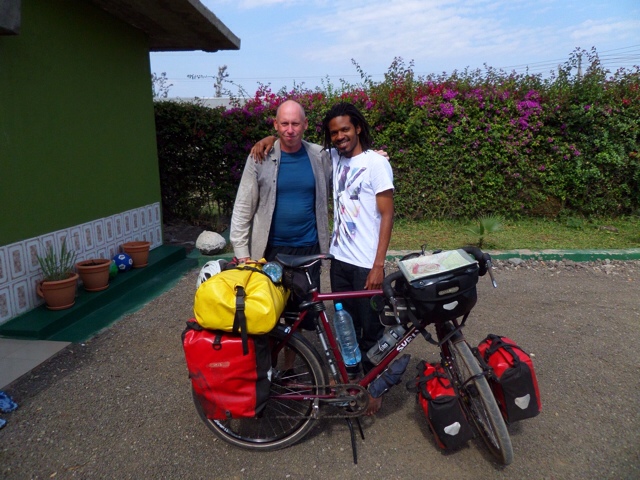
Benson and I - The Greenhouse Hostel - Arusha
After a rest and the medication kicked in I felt good enough to carry on the journey and made my way out of Arusha.
Coming the other way a guy on a homemade bike cried out “Jambo!” – hello. I doubt I will see another bike like his in a while. I wanted to get a good photo so turned round and rode a while with the guy.
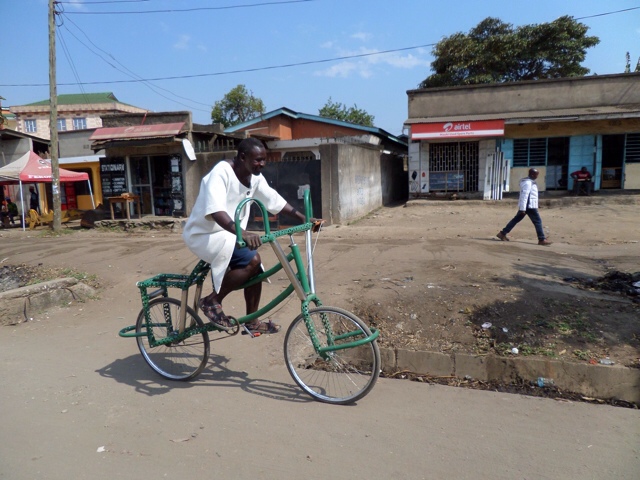
Homemade Bike - Won't see One Of These In Bikes and Boards
The riding went well, through dry arid almost desert and by lunchtime I’d done 50 miles and passed the turning for the Serengeti, so decided to carry on further. Finishing on 105 miles, I did pay the price for pushing it too much. A puncture as I came into Babati and being tired and close to guest houses I walked the last mile. A nice guy helped me find a lodge, Kahembes (bit run down but the cocktoaches were friendly) and I was able to shower and rest and mend the puncture in my room.
Before cycling in Tanzania I had been in touch with Peter Gostelow, who was one of my inspirations for cycling Africa (The Big Africa Cycle www.petergostelow.com). He’d spent a couple of years cycling from the UK to Cape Town. He was surprised I was going to camp as he explained guest houses are very cheap, around £3 to £8 per night).
Taking my merino shirt off, the rehydration salts the doctor had prescribed had worked, most of them being on my shirt at the end of the day.
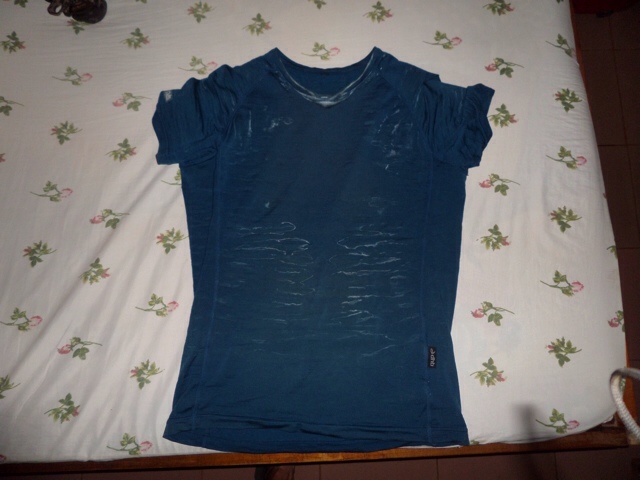
Salty Merino Shirt
The landscape out of Babati was incredible, if not hilly and windy, still very dry and arid. Many trees look dead and the only wildlife insects and the odd bird.
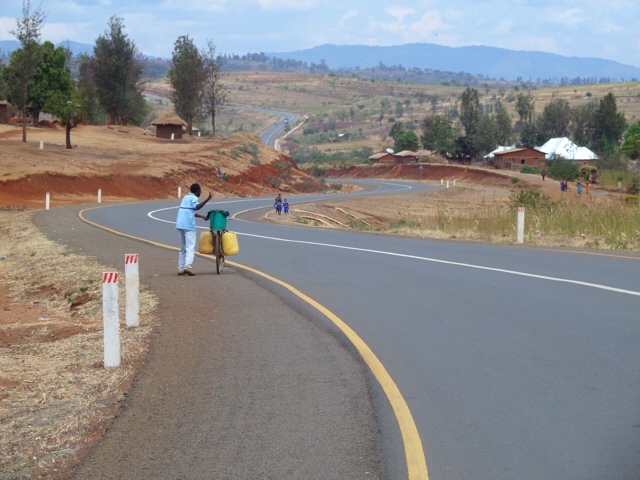
Road Out Of Babati - Tanzania
The heat rose throughout the day until mid afternoon when it’s really hot. Luckily with the wind it’s bearable to cycle in most of the time.
Coming out of one of the villages after a Soda stop (ask for a soda in a Tanzania and they know you want a cold drink), I had another puncture! This was getting rather tiring fixing punctures, five recently. Decision made, the Schwalbe supreme tyres have done over 8,000 miles so off the rear one came and on went one of the new ones I’d been carrying since leaving the UK.
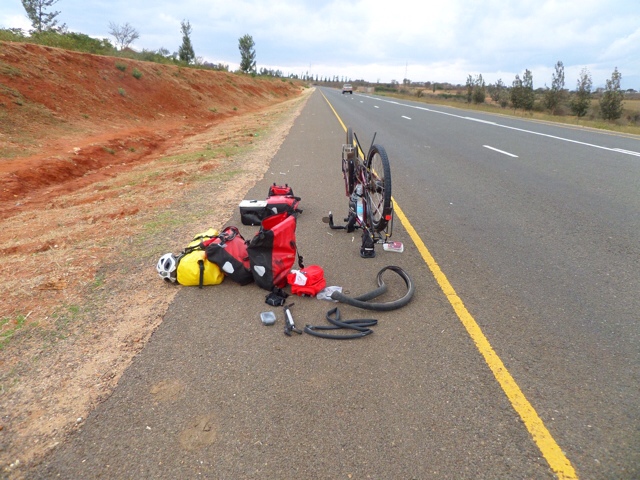
Too Many Punctures - On With A New Tyre (yes I know it's upside down!)
Following the hot, dry, windy hilly roads South West I saw in the distance Mt. Hanang, the third largest mountain in Tanzania.
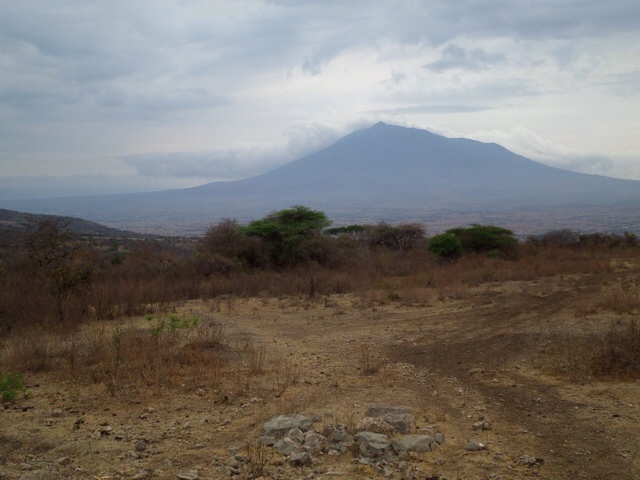
Mount Hanang - Tanzania
So far I’ve ridden over 7,000 miles with barely any problems regarding saddles and sores, that changed after leaving Arusha and for the first time I have three despite doing everything I should to avoid them (keeping clean, taking breaks, riding standing up regularly to let blood back into my backside). They were quite big sores and ranging from largest to smallest I’ve named them after the mountains that I’ve ridden past or around, Mt Kilimanjaro, Mt Meru and Mt Hanang. Hopefully they will go properly when I have my next longer break, they are bearable at the moment.
Water in East Africa doesn’t appear to be so easy to come across. Gone are the wells and pumps I saw on the other side of the continent. Now people travel further to get water from dubious sources. Dried up river beds or in some cases puddles after a rain. I should have kept my water filter. East Africa seems so far in front if West Africa in most respects other than water. Water pumps were never far away with clean good drinking water. I’m now using sodium hypochlorite (basic household bleach) to treat tap water after being ill. 8 drops of 4.5% bleach treats a 1.5 litre bottle of water.
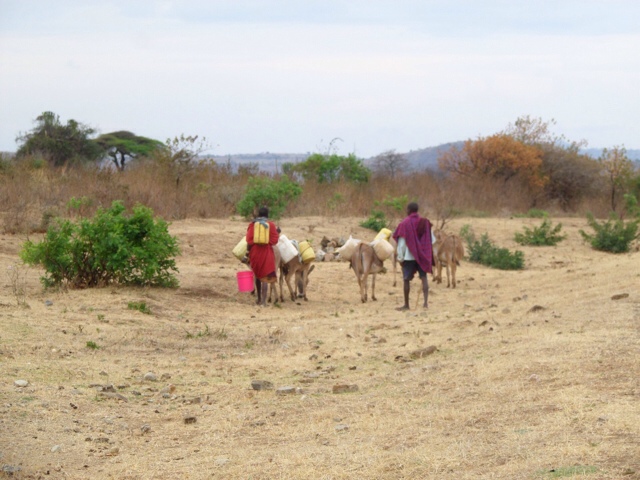
Donkeys Being Used To Fetch Water
The geology and rock formations are incredible and vary massively. One rock as I got closer looked like a hand with a thumb up, as I got sideways onto it, it looked like a thinking man.
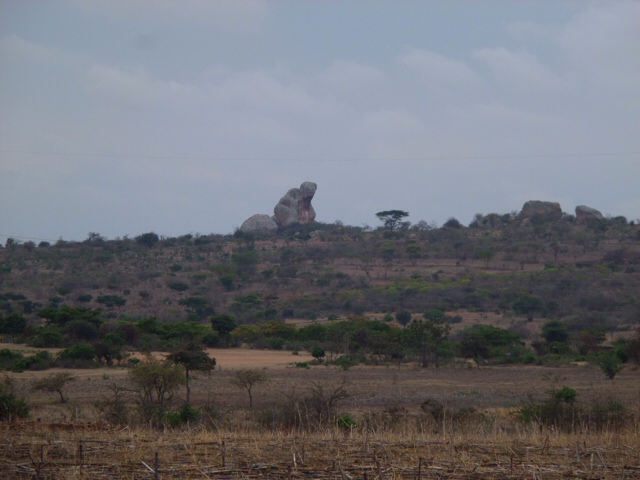
Rock Formation - Thinking Man or Thumbs Up
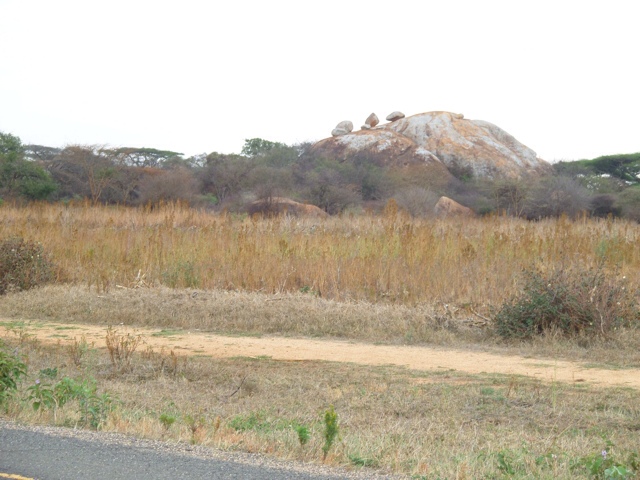
Pebbles Dropped By Giants
Other rocks just tower over the buildings that have been erected in amongst them.
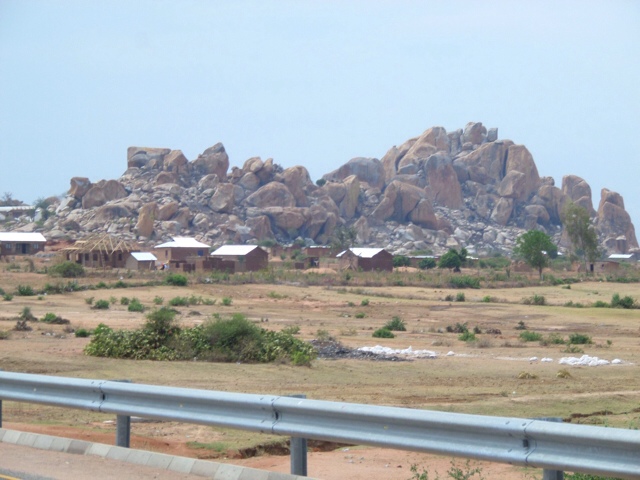
Shacks dwarfed by rocks
Tanzanian roads are covered in rumble strips. Some are viciously big and no fun to ride over, almost throwing you from the bike if you are not paying attention. They make little difference to the African lorries or bus drivers who fly over them at great speeds but cause a lot of pain to a cyclist with saddle sores. They also vibrate pannier bolts loose, lots of checks to make sure all is tight at the end of each day.
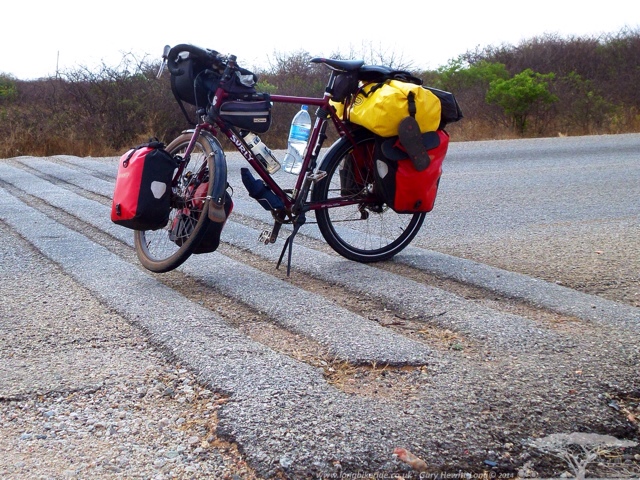
Tanzanian Rumble Strips - Painful
The large bus drivers being the worst, not slowing or moving their course for anyone. Regularly I ride off the road to avoid being hit. There are so many driving at very high speed and appear to have no intention of slowing. This is much the same as West Africa, however in West Africa the buses do change course to go around you so you don’t cycle in fear of your life. In Tanzania the bus drivers lean on the horn as warning, either move off the road or you maybe hit! I’m not much of a fan of the bus drivers in Tanzania.
The reactions of children are varied when they see me. Many ask for money which is tiring more so than west Africa where you are asked for a gift (Cadeaux). Maybe it’s because the requests are in English I find them worse. Even small children who can barely walk or talk ask while their mothers look on. Occasionally there are children just happy to see a white Muzungu cyclist, waving or cheering. With no fisher price or toy stores children make their own toys, toy cars included.
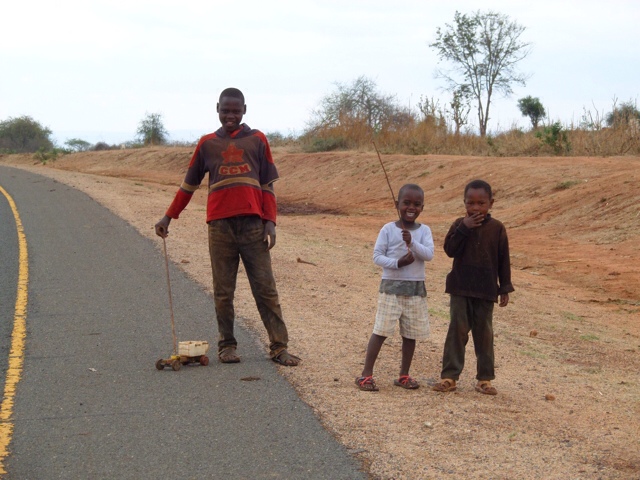
Children Playing By The Road - Not Asking For Money
At times the clouds appear, rain can be seen in the distance, I’ve been lucky to miss most of it. The ominous clouds staying over the high ground to the East of the Mangati plains.

Ominous Clouds by the Mangati Plains Tanzania
Singida is one of the larger towns on my route. I needed cash and a spare inner tube. These were easily found, although the valve on the tube looks like a cross between schrader and presta types.
Asking a policeman to recommend a good cheap guest house he advised the Stanley motel in Singida. It was nice…until the music in a bar over the road started… Until 12:30, I’m getting old and after cycling all day all I want to do is sleep (I know, 12:30 isn’t that late). As this wasn’t possible the time was best used servicing the bike and my stove. Completely stripping the stove I set about replacing filters in the pump and stove, cleaning the regulator pins, replacing the primer pad and giving it a good clean. It’d got worse performance wise while on the trip. The poor quality petrol in some cases I believe to blame for the rapid decline in performance.

Servicing My Primus Omnifuel Stove
The petrol smell from the bathroom should go after a while. After servicing it’s easier to regulate temperature and it’s like a rocket burner again on full flow.
The drag out of Singida was a relentless cross wind. Not as bad as a head wind but tiring never the less.
The road was good with ample room to the side to cycle on when the buses and lorries flew by.
Stretches of the road from Singida had lots of stalls selling honey. Riding past an NGO that was training locals in bee keeping, they obviously succeeded past their expectations. For 5 miles there were stalls every 30 to 60 yards selling honey, to the point that there looked to be too much! Most trees by the roadside were adorned with 1 or more bee hives.

Bee Hives In Trees
Cattle are out all day grazing, the Masai clothing not seen anymore, more jeans and t-shirts. When the cattle are moving dust clouds are kicked up and can be seen from a distance. The cattle and herders looking forward to the rain not only for the lush grass it will bring but also to keep the dust down.

Cattle Kicking Up Dust
Temperatures during the afternoon are high, over 30 most days. Too hot for the cattle to move. Only mad Englishmen riding out in the midday sun.

Too Hot To Be Out In The Sun - Unless Your An English Cyclist
As the heat rises impressive dust cyclones can be seen spiralling up into the sky. Looking across the plains it’s possible to see lots of them and occasionally bigger ones come close to the road, putting your head down and shutting your eyes for a couple of seconds as it passes covering you in dust and dry leaves that have been whipped up into its funnel.

Dust Cyclone
My route changed from a more direct route from Singida to Mbeya to one that went via Dodoma and Iringa. Several people I’d met had explained how bad the roads were going direct to Mbeya from Singida. To stay on mostly Tarmac had increased the route by over 100 miles, being a roadie at heart an easy sacrifice. Some of the roads are still being worked on by the Chinese. Stretches not yet open to cars. On a bicycle I only got asked to use the side dusty road once. Thankfully staying on the new road keeps you away from the worst of the big dust clouds kicked up by the lorries and buses.

Lorry Throwing Up A Dust Cloud
Getting closer to the Mtera Reservoir daylight was coming to an end. To the left a nice big tree slightly up off the road looked an ideal place to camp and watch the sun go down over the Reservoir. Sitting silently I could hear bells clanging in the distance. A few moments later I was surrounded by goats being taken home for the night.

Goats - I'm Not Kidding
In the morning the view of the sunrise was just as good.

Sunrise Near Mtera Reservoir
As I took the bike off the stand, the front tyre was flat, a thorn. Taking the opportunity I changed the front tyre to the remaining new one, so now both wheels are using Schwalbe Marathon Mondials. They look a lot chunkier and should see me to the end. I’m still carrying the old tyres until I can clean and inspect them to decide which one to keep as an emergency backup.
The route to Iringa took me down towards the Mtera Reservoir, over the Fufu escarpment. At Mtera cresting the hill the below view came into sight.

Mtera Reservoir - Tanzania
Before I could get close there was a barrier across the road. I rode around it like I normally do these barriers (they are usually for motor vehicles) and a man came running after me. Apparently I needed a visitors pass to cycle the next 1 mile over the hydroelectric dam.

Visitors Pass for Mtera Hydroelectric Dam
The Dam was very small, not in operation and not very impressive and straight after it the card was taken back.

Mtera Hydroelectric Dam - Yes That's It!
Again the heat rose, even the dogs wouldn’t venture out into the sunlight.

Hot Dogs - Too Hot In The Sun
Stopping for a rest and something to eat, I soon had a crowd wanting to know of my journey. Initially the stand owner tried to charge me double, trying his luck. I explained it should be half and he knocked more off. Bargain.

Roadside Food and Audience
Ordering food or asking for things can be fun. In Tanzania they add “y” to a lot of English words, if you want a soda, your asked if you want it coldy or hoty? Want chipsy?
When I’m not understood, adding a y to the end seems to help. Asking for Chocolate Biscuits no one knew what I was after. Ask for Chocolatey Biscuity and a look of comprehension appears and so does what I requested.
Riding away from the reservoir the path climbs to over 4,000 feet from 2,500. The Chinese have been at work again on the roads, impressively cutting away large chunks of hill to make a wider carriageway.

Road cut into the hills
As soon as the climbing starts it gets cooler, and the roads have been built with only a reasonable incline, these slow incline hills are fun to ride and it’s good to get the legs working properly.
Near the top I took a break, sat down with a banana and a packet of biscuits. A motorcycle pulled over to check I was ok, everyone wants to make sure your ok, it’s very kind and reassuring to know people will stop and help. I explained I’m just resting and enquired how far the next village was that I could get water for my overnight camp. First it was 3km, then he thought about it and said no it’s only 2km just over the top there. With reassurance I sat and rested a bit longer. Setting off I passed the 3km with no sign, just rocks and trees, 4, 5 and 6 km passed and still no sign. Eventually a shop came into view… At over 10km. Lots of the small places aren’t shown on my map. As this wasn’t, I should have learnt by now that most people I’ve met so far don’t really grasp distances.
Water obtained I set off looking for a nice spot to camp. On my right I could see the remains of a building 50 yards off the road. Waiting for the cattle to pass that were being driven home for the night I quickly pushed the bike over and covered the bright bags with my shirt. I was then able to cook tea hidden behind the wall which also sheltered the stove from the wind. The tent was put up after sunset. I don’t mind being found camped in the morning but do like to know that at night no one knows I’m there.

A nice sheltered place to camp


